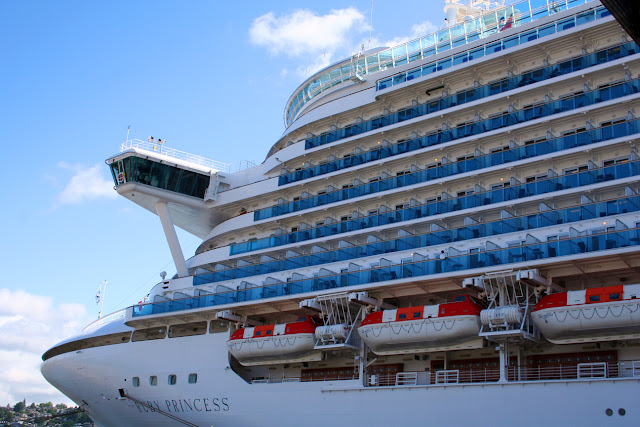Calculating the cost
With the summer cruise season about to get underway, TheTravelPro is pleased to present a series of article that will provide a more complete understanding of the all-in cost of such an adventure.
My wife and I took our first cruise in the summer of 2016, aboard Princess Cruises’ Ruby Princess. While we did not expect the fare to be all-inclusive by any means and expected additional charges for optional events including shore excursions and specialty dining, some additional charges might be surprising, particularly to first-time cruisers.
 |
| The Ruby Princess at Seattle's Pier 91 |
The fare is just the starting point
We have all seen the “teaser” ads that say, “Cruise to Alaska for just $599 per person, double occupancy,” and the disclaimer that “Taxes, fees and port charges” are additional. Of course that low rate is for the ship’s least-expensive accommodation -- usually an inside cabin without a view – and often either toward the beginning or end of the season. Outside cabins, verandah suites, larger accommodations and more preferential sailings will come at higher fares.
In addition to higher fares for a better stateroom than an inside cabin and more prime-time sailings, there are numerous options and additional charges that will be added to the fare.
If you are not departing from the city in which you live, you will have to get to your departure port. That will involve some sort of common-carrier transportation, which will more than likely be an airplane flight, followed by a transfer from the airport to the port, and a transfer from the port to the airport upon your return.
Our cruise line offered transfers for $24 per person in each direction, or $96 for a couple for the round trip from Seattle-Tacoma International Airport (SEA) to the Smith Cove Cruise Terminal at Pier 91 and back to the airport at the end of the cruise. Passengers might also add a few dollars to tip the person handling their bags.
At the time of booking, our cruise line presented us the option of travel insurance. While its protection package was $190.30 per passenger, the credit card we used to pay for the cruise included travel protection, so for us it would have been an unnecessary purchase. Others may find value in the protection proffered.
A number of options were available on board the ship, including a beverage package. Our line offered an “All-inclusive beverage package” that included “[A]ny drink up to $10 including cocktails, wine, beer, bottled water, sodas, specialty coffees & more [and a] 40% discount on bottles of wine (below $100 retail).” The cost of that package: $56.35 per person per day ($49 plus a 15-percent gratuity), or $394.45 per person for our seven-night voyage. The cruise line also offered soda, coffee, beer and bottled water packages.
 |
| Menu at SHARE aboard Ruby Princess |
Specialty dining is another option. While meals are included in the cost of the fare, most cruise ships have at least one specialty dining option for which there is an additional charge. One of the three on our cruise was a restaurant created in conjunction with celebrity chef Curtis Stone. Dinner at that particular venue, called SHARE, was a minimum of $39 per person, or about $78 per couple. Alcoholic beverages were extra unless a guest has purchased the beverage package.
Shore excursions were plentiful but organized activities come at a cost. Our ship stopped at five ports of call and guests can choose from over 100 shore activities ranging from $29.95 per person to $1,995.95 per person. In addition, independent operators were waiting at each port, so guests could engage their services -- often at a lower cost than the cruise line offered. Finally, passengers could simply disembark and follow their noses at no charge.
Internet connectivity was available for a fee. Internet access for those who just have to stay connected ranges from $72.95 for 120 minutes to $202.95 for 680 minutes.
On board activities included a fitness center, which was free, but a fitness class or a session with a personal trainer carried an additional charge. Spa services also carried price tags which were comparable to those of a spa at a high-end resort. For example, a 50-minute couples’ massage is $259 and a 50-minute Swedish massage is $119.
There were also gift shops, professional photographers, child care, casinos, and other items not included in the ticket price.
Finally, many cruise lines add “suggested” or “recommended” gratuities for their passengers’ convenience. For our cruise and cabin class, the line added $13.95 per person per day, though guests can choose to tip independently in addition to the daily amount, or they can have the amount adjusted prior to disembarking if they prefer.
Are these expenses worthwhile? And how do you decide? More on that in upcoming installments.
Visit my main page at TheTravelPro.us for more news, reviews, and personal observations on the world of upmarket travel.
Photos by Carl Dombek
Click on photo to view larger image
Comments
Post a Comment
PLEASE NOTE:Comments on this website must pertain to the topic of the article and may be edited for content and/or clarity. Comments that include URLs WILL NOT BE POSTED. Please contact me directly if you wish to do a "link exchange."